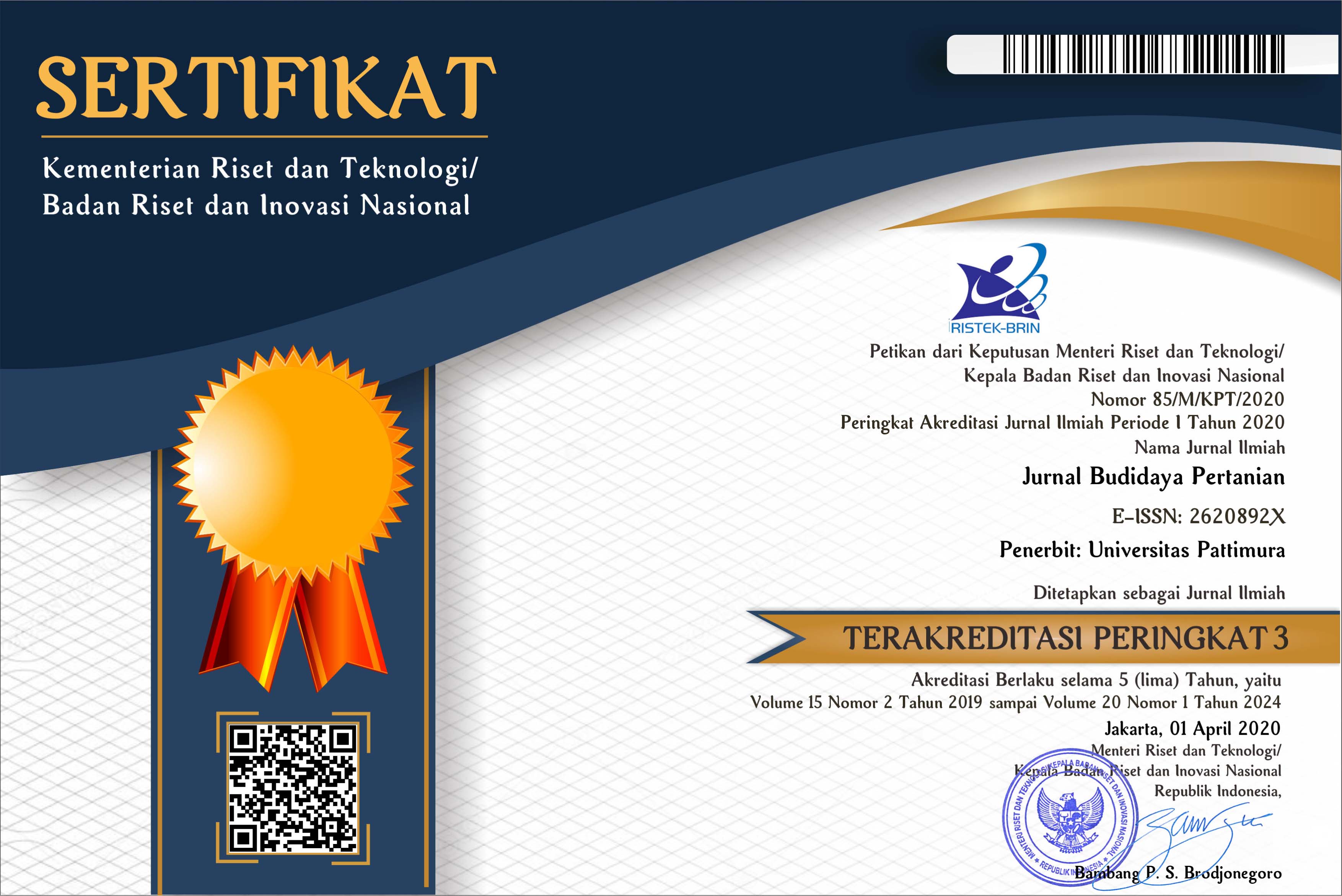Peranan Bahan Organik dan Pupuk Majemuk NPK dalam Menentukan Percepatan Pertumbuhan Tanaman Jagung (Zea mays Saccharata L.) pada Tanah Inceptisol (Suatu Kajian Analisis Pertumbuhan Tanaman)
Abstract
Agricultural management is currently facing the adverse effects of inorganic fertilizers; thus, the use of organic fertilizers should be encouraged, one of which is the use of compost. Organic fertilizers are fertilizers that are mostly or wholly composed of organic materials derived from plants and/or animals through decomposition process. It can be in solid or liquid form used to supply plant nutrients, improve physical, chemical and biological properties of the soil to accelerate the plant growth. On the other hand, the inorganic fertilizer is still used, although only as a basic fertilizer, while the combination of both organic and NPK inorganic fertilizer as a balanced treatment can generate the best growth and development of the plant. The aims of this research were to: 1) determine the best dose of compost and NPK compound fertilizer for vegetative growth of sweet corn; and 2) determine the dose of compost to determine the best plant biomass filling for sweet corn plant growth. This research was conducted in the greenhouse of Faculty of Agriculture Pattimura University, Ambon using two factors in factorial design in Complete Randomized Design, with three replications where the first factor was compost as K (without compost, 10 tons/ha, 20 tons/ha and 30 tons/ha) and the second factor is NPK compound fertilizer as P (without NPK compound fertilizer, 50 kg/ha and 100 kg/ha), so there were 36 experimental units. Against the observed variables of plant height, number of leaves and stem diameters measured every week for an interval of five weeks, the design of Split in Time using PROC GLM SAS 14 was used, while for the variables fresh and dry weight of plant (roots and above ground) PROC GLM SAS 14 was used. If there was a significant effect of the compost and NPK fertilizer treatment on the soil and plant observation variables, it was followed by Duncan multiple range (DMRT) test using PROC GLM SAS 14, Step wise analysis and orthogonal polynomial regression for composting factor and the best compound fertilizer in this experiment using MINITAB 17. The results showed that compost and NPK compound were able to accelerate the growth rate of corn plant, and the best time occurred in the fourth week after planting, where compost with dose 20-30 tons/ha combined with NPK compound 50-100 kg/Ha showed the best results for vegetative growth of corn plant.
Downloads
References
Bot, A. and J. Benites, 2005. The Importance of Soil Matter, Key to Drougth Resistant Soil and Sustained Food Production. FAO Soil Bulletin.
Dewanto, F., J.J.M.R. Londok, R.A.V. Tuturoong, dan W.B. Kaunang. 2013. Pengaruh Pemupukan Anorganik dan Organik terhadap produksi tanaman Jagung Sebagai Sumber Pakan. Jurnal Zootek 32: 10-22.
Hardjowigeno, S. 2010. Evaluasi Kesesuaian Lahan dan Perencanaan Tataguna Lahan. Gadjah Mada University Press, Yogyakarta.
Havlin, J.L., J.D. Beaton, S.L. Nelson, and W.L. Nelson. 2005. Soil Fertility and Fertilizers, An Introduction to Nutrient Management. Pearson, Prentice-Hall, New Jersey.
Husodo, S.Y. 2002. Pupuk Majemuk Berimbang, Produktivitas Padi Nasional dan Perlindungan terhadap Petani Produksen. Dalam Adiningsih J.S. et al. Prosiding dan Lokakarya Pupuk Berimbang. Lembaga Pupuk Indonesia hal. 5-18.
Korschens, M. 1997. Dependence of soil organic matter (SOM) on location and management, and its influence on yield and soil properties. Archives of Agronomy and Soil Science 41: 435-463.
Martodireso, S. dan W.A. Suryanto. 2001. Terobosan Teknologi Pemupukan dalam Era Pertanian Organik. Kanisius Yogyakarta.
Nurdin, P. Maspeke, Z. Ilahude, dan F. Zakaria. 2009. Pertumbuhan dan Hasil Jagung yang di pupuk N, P dan K pada tanah Vertisol Isimu Utara Kabupaten Gorontalo. Jurnal Tanah Tropika 14: 49-56.
Nyoman, P. 2010. Kompos. Pusat Penelitian Antar Universitas Ilmu Hayati LPPM-ITB. Departement Biologi, Fakultas MIPA, ITB. Bandung.
Prihatini, T. 2001. Menuju “Quality Control†Pupuk Organik. PPPT dan Agroklimat. BPPP. Seminar Berkala PERMI, Bogor (Juli 2001).
Starbuck, C.J. 2004. Waste Management Alternative: Composting. Universityof Nottingham School of Biosciences, Scientific Program, Nottingham.
Tomasoa, R. 2014. Pengaruh Pemberian Kompos Dengan Menggunakan Bioaktivator EM4 dan Promi Terhadap Pertumbuhan dan Produksi Tanaman Jagung (Zea maysL. Saccharata) Di Tanah Inceptisol. (Tesis). Program Pascasarjana Universitas Pattimura, Ambon.

 Accreditation is valid for 5 years, starting from Volume 15 Issues 2 December 2019 up to Volume 20 Issue 1 June 2024.
Accreditation is valid for 5 years, starting from Volume 15 Issues 2 December 2019 up to Volume 20 Issue 1 June 2024.






